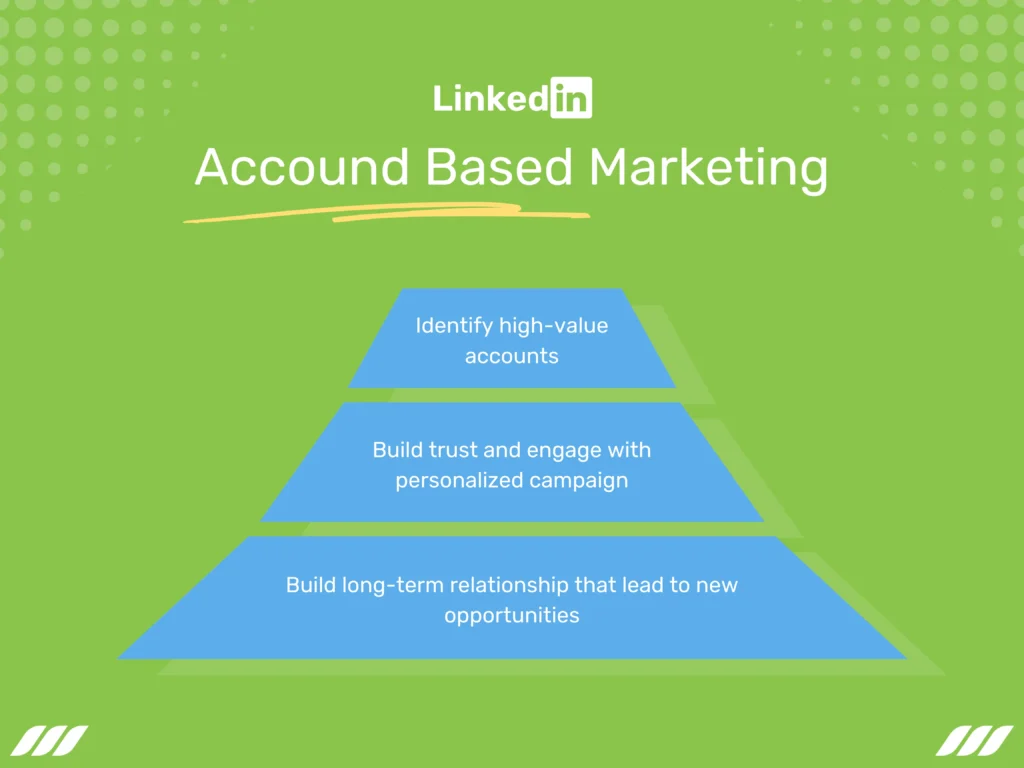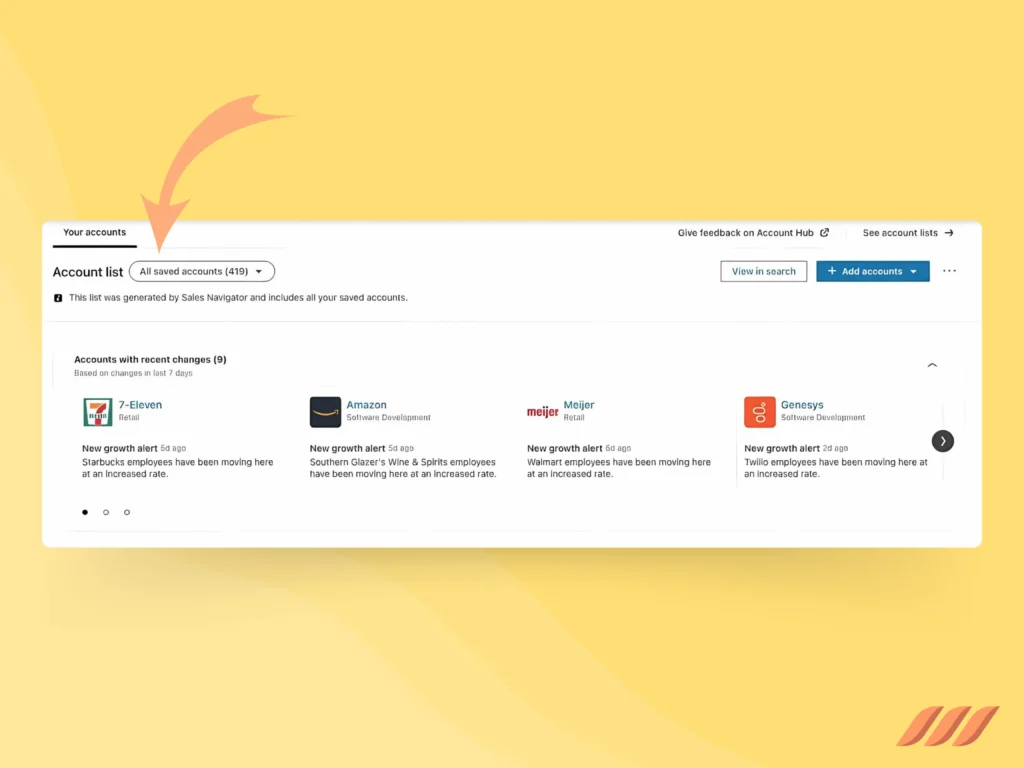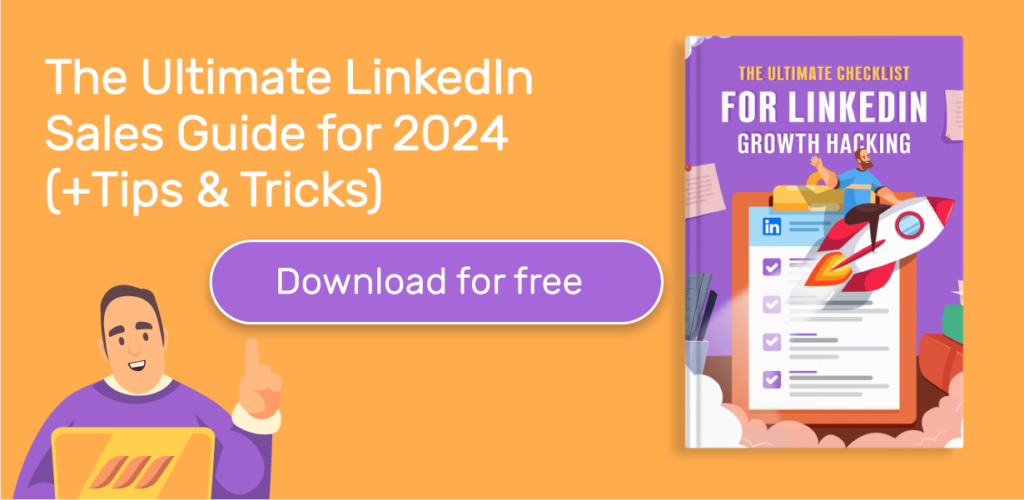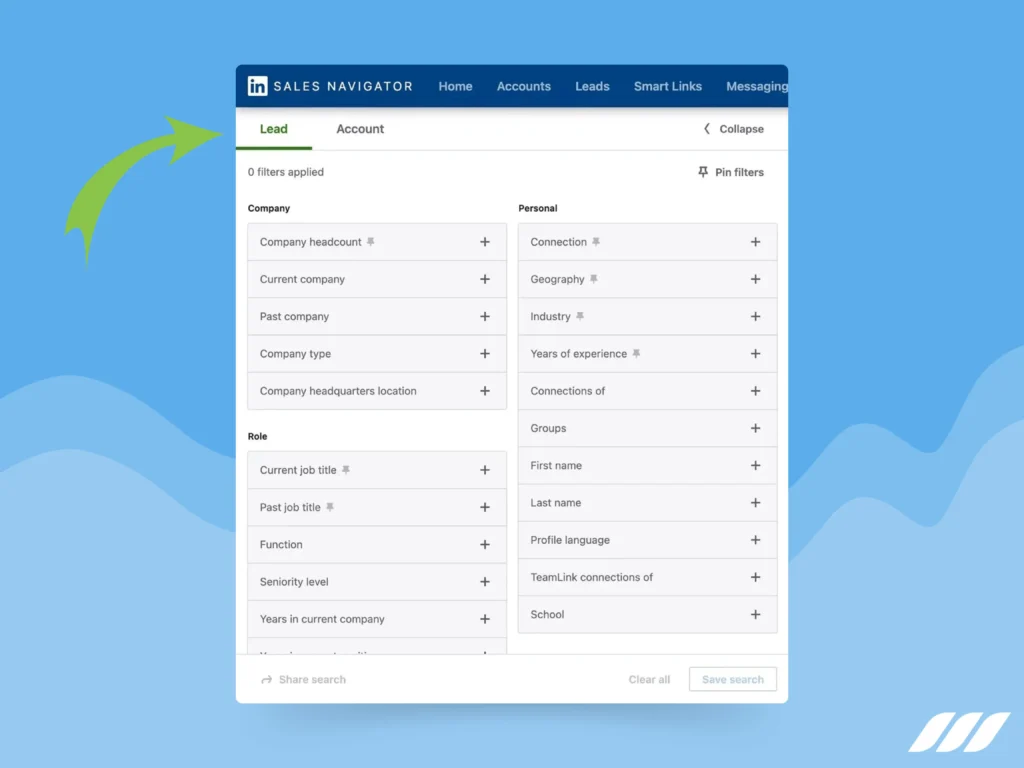|
Getting your Trinity Audio player ready...
|
Do you wonder how some top-notch sales and marketing teams are scoring big wins in B2B? Well, here’s the secret sauce: LinkedIn Account Based Marketing (ABM).
As LinkedIn ABM gains traction, sales professionals are using it to zero in on specific companies and key leads. And if you’re eyeing those game-changing deals and aiming to rub shoulders with the big players, it’s high time you tap into the LinkedIn ABM.
Now, you might have caught wind of the term “ABM” in marketing chit-chats, but let’s get real – what’s it all about? How does LinkedIn account-based marketing actually work? And, most importantly, how can you make the most of this approach?
We’ll explore everything you want to learn about ABM on LinkedIn, from what it is to how it works and everything in between.
What Is Account-Based Marketing on LinkedIn?

LinkedIn account-based marketing is a game-changer approach where the sales journey kicks off with the direct targeting of your ideal, high-value accounts. No more wasted time on marketing efforts aimed at leads that don’t align with your business. Instead, you can swiftly engage with your precisely chosen target accounts.
It’s all about efficiency at its finest. Account-based marketing streamlines the process, enabling you to identify and prioritize valuable companies from the get-go, ensuring seamless alignment between Marketing and Sales.
Unlike the conventional funnel where quantity takes center stage, ABM on LinkedIn zeroes in on specific accounts, transforming them into customers and loyal advocates for your brand.
Imagine this scenario: In the traditional approach, Marketing gets the directive: “Go fetch some leads!” This leads to an influx of inbound strategies, such as ads and content creation, all geared toward capturing Marketing Qualified Leads (MQLs).
But, here’s the snag – when Sales steps in for the qualification call, there’s often a gap between what Marketing deems a lead (MQL) and what Sales consider a worthy lead (SQL). It’s a classic case of miscommunication, and Sales finds itself drowning in a sea of unqualified leads.
Now, let’s see it from the perspective of LinkedIn Account Based Marketing.
In this model, the order isn’t just “Go bring leads”! It’s more about quality than quantity – making every Sales call count.
ABM transforms the LinkedIn lead generation game, taking your marketing from a scattergun mess to a laser-focused mission. No more waiting for leads to stumble upon your content; now, you proactively connect with decision-makers, turning those connections into tangible conversions. It’s not about waiting; it’s about winning.
Think of ABM as a matchmaker for Marketing and Sales:
- Marketing and Sales collaborate to cherry-pick the dream accounts they aspire to turn into valued clients.
- Sales and Marketing unite as the ultimate power couple, working together to secure those pivotal meetings with the big players.
- Sales isn’t wasting time on calls with less promising prospects. Now, every meeting is a chance to connect with prospects who aren’t just interested but genuinely qualified.
So, in a nutshell, LinkedIn ABM isn’t just a strategy; it’s a shift in mindset. It’s about precision, collaboration, and turning connections into conversions that truly matter.

How Does LinkedIn Account-Based Marketing Work?
Now that you’ve got the basics down, let’s explore how to make Account-Based Marketing (ABM) work on LinkedIn. Remember, we’re not just trying out a new trick; we’re building a solid strategy that needs everyone on board.
Here’s the key: You must have a LinkedIn Sales Navigator subscription, as it is crucial for unleashing the full power of LinkedIn ABM. Think of it like your guide in the vast sea of LinkedIn to find leads that truly matter to your business.
1. Team Onboarding
It is essential to acknowledge that ABM on LinkedIn is a collective effort. This isn’t a fleeting experiment but a transformative strategy, so getting everyone on board is crucial.
To get started, convince your Sales & Marketing Team and executives to join the program. Without the full engagement of these three vital components, implementing ABM on LinkedIn within your company can pose challenges. If you’re the one reading this, chances are you’re the person who needs to bring your colleagues together – so be ready to allocate resources.
- Bring your crew together and share success stories of companies that leveraged ABM.
- Convey to your executives that they are the commanders steering the ship toward unparalleled growth.
- Unite your team, ignite their enthusiasm, ensure everyone is on the same page, and let the LinkedIn ABM adventure commence!
2. Get Sales Navigator for ABM Success
As stated before, you’ll need to use LinkedIn Sales Navigator to ensure the success of your ABM strategy. This tool is your gateway to a specialized database designed specifically for ABM.
Here’s a quick rundown of how you can leverage it:
- Search for Accounts: Dive into LinkedIn’s extensive database to identify the companies that align with your ABM goals. Sales Navigator lets you zero in on the right accounts efficiently.
- Build Account Lists: Once you’ve identified your target companies, Sales Navigator helps you organize and prioritize them. It’s like having a personalized ABM toolkit to streamline your approach.


- Find Decision Makers: Pinpoint the key decision-makers within your target accounts effortlessly. Sales Navigator provides insights to ensure you’re connecting with the right people who can drive decisions.
- Create Targeted LinkedIn Ads: Tailor your ads to perfection. With Sales Navigator, you can craft LinkedIn ads that resonate specifically with your identified audience on LinkedIn. It’s about precision targeting for maximum impact.
3. Create Your ICP
Before tapping into the expansive LinkedIn database, imagine, for a moment, the perfect clients for your product or service. Then, describe your Ideal Customer profile in clear terms.
To create an effective ICP:
- Examine Your Current Clients: Your existing clients hold valuable insights that can fuel the growth of your business. What industries are they part of? How large are their operations? These specifics form the foundation of your Ideal Customer Profile (ICP), and your current clients play the starring role in shaping the narrative of your success story.
- Static Signals: Now, let’s give your Ideal Customer Profile (ICP) a solid framework. Static signals provide a sneak peek into a company’s current position. Examine factors like industry, department sizes, and physical location.
- Dynamic Signals: Dynamic signals, like engaging in fundraising or launching new products, infuse vitality into your Ideal Customer Profile (ICP). These signals offer glimpses of opportunities, indicating which companies are poised for active engagement.
This combination paints a canvas with a variety of accounts, each playing a unique role. Some take center stage as the stars of your narrative, while others contribute crucial supporting roles. Prioritizing your Ideal Customer Profile helps you identify the main characters driving your success and essential contributors to your growth.
Once you’ve defined your ICP, you can use it to tailor your approach to each account on LinkedIn. This personalized strategy transforms your efforts from generic outreach to targeted, meaningful conversations that resonate with the unique needs of each potential client.
4. Categorize Accounts With The ABM Tiers System
In this step, we’ll discuss putting your accounts into different groups! Remember, it’s not just about finding potential customers; it’s about figuring out how important they are for your business and adjusting your plans accordingly.
Tier I: Must-Have – The Core Accounts
What to do: Tier I comprises the really important accounts that your business needs to succeed. They’re usually big companies and brands. As such, your top salespeople will take charge here, getting up close with a more personalized approach.
Why it matters: These accounts are the most crucial pieces in your success story. They’re not just important but also lay the base for your success. For this reason, getting them on board isn’t just a win; it’s a big leap toward achieving your goals.
Tier II: Essential Ensemble
What to do: Consider a smoothly coordinated team where your Sales Development Representatives (SDRs) lead the way. They use tailored strategies to interact flawlessly with crucial clients. The goal is to communicate effectively and seamlessly with these key clients.
Why it matters: These clients are like the main support for your income. Even though they don’t grab all the attention, they play super important roles in telling your company’s story. Since they’re easier to work with, they keep adding to the steady progress of your business.
Tier III: Pleasant Additions
What to do: Imagine using a friendly and straightforward approach, like casting a wide net to connect with easy opportunities.
Why it matters: These accounts may not be in the spotlight, but they bring in extra revenue, enriching your business.
In a nutshell, each tier discussed above has its unique role.
As you can see, Tier I means careful manual approaches, Tier II uses a well-organized strategy, and Tier III centers on efficient and coordinated approaches.
You can achieve greater, long-term success by having these Tiers work in harmony.


5. Organize Your Account Lists Using LinkedIn Sales Navigator
Now that you have established your tiers, it’s time to implement your strategy using LinkedIn Sales Navigator.
Here’s a simple guide:
- Account Search: Open LinkedIn Sales Navigator and head to the Account Search feature. Now, you can tap into powerful search filters such as industry, location, and industry to narrow down your search and find exactly what you need.
- Add to Account List: After refining your search and pinpointing accounts that fit your tiers, you’re at the crucial next step. Go on and add the selected accounts to a dedicated Account List. Think of this list as a carefully curated collection tailored to match your business goals.
- Repeat for Tiers 2 and 3: This process isn’t a one-off task. As such, you must repeat the steps for Tiers 2 and 3. Since each tier may have different criteria and elements, it is a good idea to customize your searches carefully. Doing so will ensure all tiers are properly present in your LinkedIn Sales Navigator strategy.
6. Identify Decision Makers With The Lead Search
Now that you have your account lists sorted, it’s time to focus on locating the decision-makers within your selected organizations. This involves a strategic Lead Search to hone in on the key individuals who can influence your business trajectory.
Here’s how to do it:
Go to Lead Search: Head to the Lead Search feature and open the Account List filter. Choose the relevant list from your accounts. Leverage the job title filter to precisely identify the decision-makers within these companies.


Use Sales Navigator’s Boolean Search: Next, it’s time to take advantage of LinkedIn Sales Navigator’s Boolean search to improve your results further. This powerful tool allows you to use logical operators to customize your search criteria.
Repeat for Tiers 2 and Tiers 3: Redo the steps for Tiers 2 and Tiers 3, tweaking your search criteria to align with the specific characteristics of each tier. This ensures you’re targeting decision-makers effectively across all tiers.
7. Export LinkedIn Search Results to CSV and Discover Emails
Now that you have pinpointed the decision-makers, it’s time to organize and prepare for outreach.
Here’s a quick guide:
Save Them: Save the identified decision-makers into a lead list since you’ll need them down the road.
Export to CSV With Your CRM: Use this method to export the data into a CSV file integrated with your Customer Relationship Management (CRM) system. The best CRM tools clean and filter the data and ensure a clean list by verifying emails. Discover what is email verification and why it’s important. This step enhances the accuracy and effectiveness of your outreach efforts.
8. Streamline LinkedIn ABM Targeting with Saved Searches


This step will ensure you never miss out on new opportunities. Thankfully, you can automate this process with Saved Searches.
Also, ensure you stay updated with LinkedIn’s weekly updates on new companies aligning with your filters, keeping you ready to explore fresh possibilities.
This combined approach of Saved Searches and Weekly Updates will help you attract new, qualified opportunities automatically. This strategy helps maintain a consistently filled pipeline with potential leads.
9. Keeping Adding New Decision Makers to Your Campaigns
Keep things moving forward through new lists creation and adding new decision-makers to those lists. This way, you can rest assured you’ll have a constant flow of leads in your sales pipeline.
10. Kick Off Your Outreach
To kickstart your outreach efforts, it is a good idea to begin by connecting with individuals lower in the organizational hierarchy.
Here’s how:
Identifying Top Executives: Start by engaging with individuals lower on the corporate ladder to gain valuable insights. Also, leverage these conversations to identify the key top executives within the organization.
Meeting Arrangements: Once you’ve identified the key decision makers, you can reach out to them and propose meetings and explore opportunities.



Conclusion
So, there you have it: a game-changing strategy for your B2B business on LinkedIn. Simply follow the steps explained above to find and target those high-value accounts, connect with key decision-makers, and build meaningful relationships.
Here’s the deal – success in ABM on LinkedIn is all about being precise, personal, and persistent. You want to hit the bullseye with your targeting, make it personal for your audience, and keep at it. It’s not just steps; it’s a strategy tailored to your business.

![How to Write a Price Increase Letter [Tips, Examples, and Free Template]](https://dripify.io/wp-content/uploads/2021/12/27.png)
![How to Write an Effective Collaboration Email [+Templates]](https://dripify.io/wp-content/uploads/2023/05/13.png)



